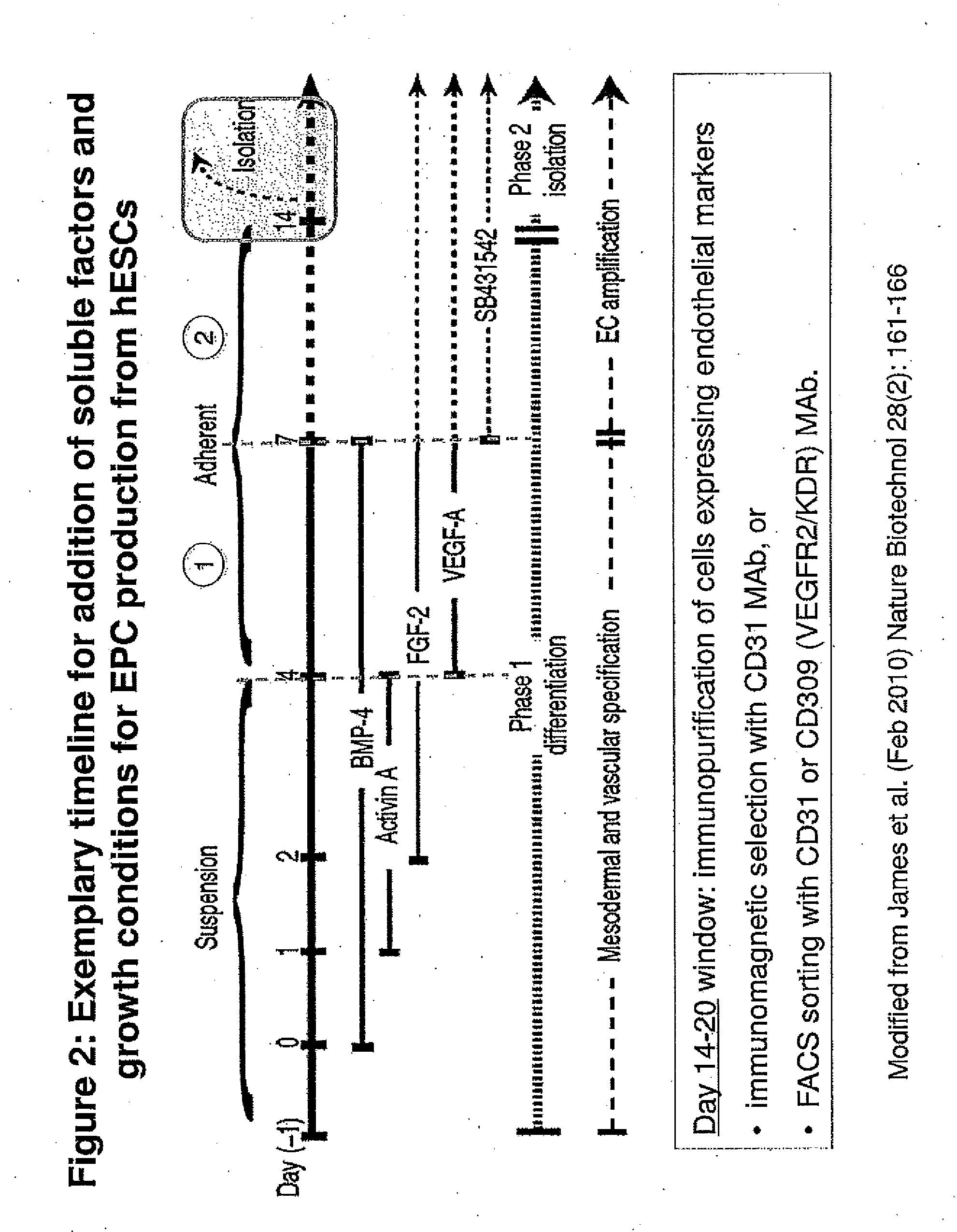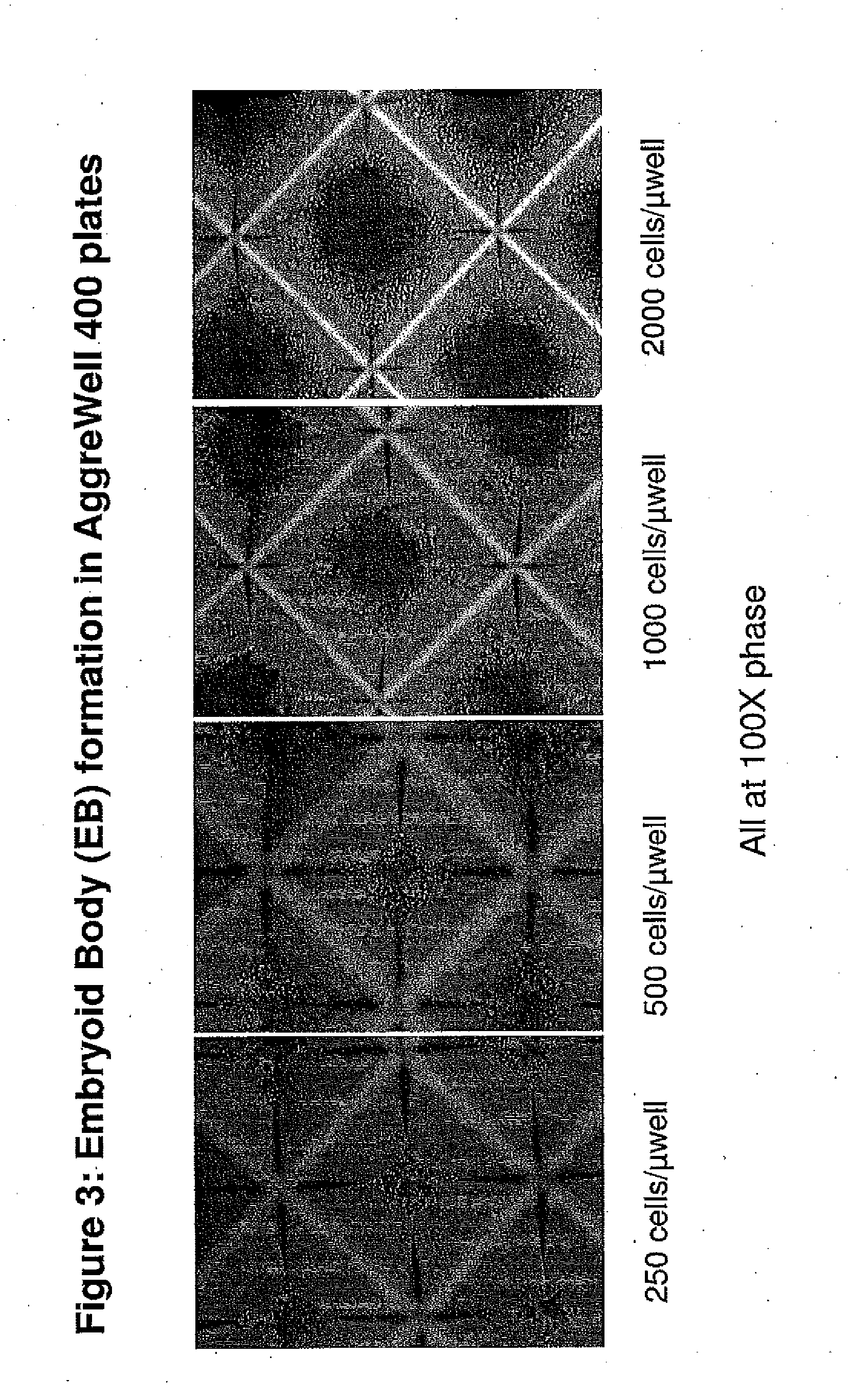Methods and Compositions for Producing Endothelial Progenitor Cells from Pluripotent Stem Cells
a technology of endothelial progenitor cells and compositions, which is applied in the direction of embryonic cells, cell culture active agents, artificial cell constructs, etc., can solve the problems that the epcs are not always abundant in the circulating blood or bone marrow
- Summary
- Abstract
- Description
- Claims
- Application Information
AI Technical Summary
Benefits of technology
Problems solved by technology
Method used
Image
Examples
example 1
Production of Human Endothelial Progenitor Cell (hEPC) from ES Cells
[0161]Human Embryonic Stem Cells (hESCs)
[0162]hESCs of various lines (e.g., H1, H9, ESI 017, ESI 035, ESI 051) were routinely maintained in mTeSR1™ medium (Stem Cell Technologies, Vancouver, BC) on Growth Factor-Reduced Matrigel-coated T flasks or cell culture plates. The cells were detached and harvested for experiments using Accutase when colonies became 50-80% confluent.
Embryoid Bodies (EBs)
[0163]To produce EBs of uniform size, 2.4 to 3.0 million ES cells in complete Stemline II basal medium (containing 1× Glutamax, 1× penicillin / streptomycin, and 50 μM β-mercaptoethanol) and also containing 10 uM Y27632 Rock inhibitor were added to each well of AggreWell 400 plates (Stem Cell Technologies; ca. 1200 microwells / well in a 24 well plate format). The plates were centrifuged essentially according to the manufacturer's supplied directions, depositing 2000 to 2500 cells / microwell, and the plates were then cultured in a ...
example 2
Gene Expression Analysis of EPCs
A. Expression of LYVE-1 in EPCs
[0176]Day 15 cultures of H9 (WA-09) ES cell-derived EPCs were positively selected or depleted for CD31 antigen expression using CD31 MicroBead Kits (Miltenyi Biotec) according to the kit instructions. The positively selected cells were cultured in T flasks for another 6 days directly on the tissue culture treated plastic surface (M+SP), on a layer of Matrigel (M+SM, or in complete EGM-2 medium (M+EGM). The flow-through fraction from the CD31 MicroBead selection (CD31 depleted but containing residual CD31 positive cells) was secondarily sorted into CD31 positive (D+SP) and negative (more highly depleted); (D−SP) fractions using a Dynabeads CD31 kit (Invitrogen), and these cells were also cultured for another 6 days on tissue culture treated plastic. The cultures were then harvested and RNA was extracted for analysis.
[0177]FIG. 13 shows LYVE-1 expression data from microarray analysis of the purified EPCs showing a positive...
example 3
[0190]Most solid tumors eventually require the formation of neo-vasculature for continued growth and metastases. This dependence on angiogenesis has been exploited in anti-cancer therapies with monoclonal antibodies, small molecule inhibitors, and cell-based approaches. Among the latter strategies is a so-called “Trojan horse” approach that includes ex vivo derivation and “arming” of tumor-homing cells followed by their systemic delivery and release of a toxic payload at the tumor.
[0191]As a first step toward such a Trojan horse approach, we have established a highly efficient process for the derivation of endothelial progenitor cells (EPCs) from human embryonic stem cells (hESCs). Our process to date has reproducibly provided high cell yields (>4×108 cells) and purities (approaching 99%) within 2-3 weeks of culture initiation. These cells display phenotypic (morphology, cell surface antigen, and gene expression) and functional vascular endothelial cell characteristics (tube formati...
PUM
 Login to View More
Login to View More Abstract
Description
Claims
Application Information
 Login to View More
Login to View More - R&D
- Intellectual Property
- Life Sciences
- Materials
- Tech Scout
- Unparalleled Data Quality
- Higher Quality Content
- 60% Fewer Hallucinations
Browse by: Latest US Patents, China's latest patents, Technical Efficacy Thesaurus, Application Domain, Technology Topic, Popular Technical Reports.
© 2025 PatSnap. All rights reserved.Legal|Privacy policy|Modern Slavery Act Transparency Statement|Sitemap|About US| Contact US: help@patsnap.com



